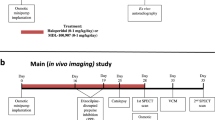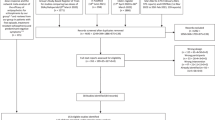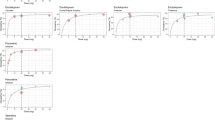Abstract
The objective of this study (NCT01854944) was to assess D2/D3, 5-HT1A, 5-HT2A and serotonin transporter (SERT) occupancies of brexpiprazole in adult subjects with schizophrenia in order to identify the in vivo pharmacologic profile that may be relevant to the antipsychotic, antidepressant, and side effect profiles of the drug. Subjects were grouped into three independent cohorts of four subjects each. All subjects underwent positron emission tomography (PET) scans with two different radiotracers at baseline prior to brexpiprazole administration, and again on Day 10 after daily doses of either 4 mg (Cohorts 1 and 2), or 1 mg (Cohort 3). Cohort 1 received scans with [11C]-(+)-PHNO to measure D2 and D3 receptor occupancy and [11C]CUMI101 to measure 5-HT1A occupancy; Cohort 2 received [11C]MDL100907 for 5-HT2A occupancy and [11C]DASB for SERT occupancy; Cohort 3 underwent scanning with [11C]-(+)-PHNO and [11C]MDL100907. Five female and seven male subjects, aged 42 ± 8 years (range, 28–55 years), participated in this study. Dose dependency was observed at D2 receptors, with occupancies reaching 64 ± 8% (mean +/− SD) following 1 mg/day and 80 ± 12% following 4 mg/day. D3 receptor availability increased following 1 mg brexpiprazole treatment and did not change with 4 mg. Robust and dose-related occupancy was also observed at 5-HT2A receptors. Negligible occupancy (<5%) was observed at 5-HT1A and SERT at 4 mg/day. In summary, brexpiprazole demonstrated in vivo binding to D2 receptors and 5-HT2A receptors at steady state after 10 days of daily administration in a dose dependent manner, while binding to D3, 5-HT1A receptors and SERT was not detectable with the radiotracers used for these targets. This pharmacologic profile is consistent with the observed antipsychotic and antidepressant effects.
Similar content being viewed by others
Log in or create a free account to read this content
Gain free access to this article, as well as selected content from this journal and more on nature.com
or
References
Maeda K, et al. Brexpiprazole I: in vitro and in vivo characterization of a novel serotonin-dopamine activity modulator. J Pharm Exp Ther. 2014;350:589–604.
Slifstein M, et al. In vivo affinity of [18F]fallypride for striatal and extrastriatal dopamine D2 receptors in nonhuman plrimates. Psychopharmacology. 2004;175:274–86.
Slifstein M. et al. NNC 112 selectivity for dopamine D-1 and serotonin 5-HT2A receptors: a PET study in healthy human subjects. J Cerebr Blood Flow Metab. 2007;27:1733–41.
Ekelund J, et al. In vivo DA D(1) receptor selectivity of NNC 112 and SCH 23390. Mol Imaging Biol. 2007;9:117–25.
Catafau AM, et al. Imaging cortical dopamine D1 receptors using [11C]NNC112 and ketanserin blockade of the 5-HT 2 A receptors. J Cereb Blood Flow Metab. 2010;30:985–93.
Kapur S, Zipursky R, Jones C, Remington G, Houle S. Relationship between dopamine D-2 occupancy, clinical response, and side effects: A double-blind PET study of first-episode schizophrenia. Am J Psychiatry. 2000;157:514–20.
Nordstrom AL, et al. Central D2-dopamine receptor occupancy in relation to antipsychotic drug effects - a double-blind pet study of schizophrenic-patients. Biol Psychiatry. 1993;33:227–35.
Kapur S, Zipursky RB, Remington G. Clinical and theoretical implications of 5-HT2 and D2 receptor occupancy of clozapine, risperidone, and olanzapine in schizophrenia. Am J Psychiatry. 1999;156:286–93.
Kegeles LS, et al. Dose-occupancy study of striatal and extrastriatal dopamine D2 receptors by aripiprazole in schizophrenia with PET and [18F]fallypride. Neuropsychopharmacology. 2008;33:3111–25.
Girgis RR, et al. Preferential binding to dopamine D3 over D2 receptors by cariprazine in patients with schizophrenia using PET with the D3/D2 receptor ligand [(11)C]-(+)-PHNO. Psychopharmacology. 2016;233:3503–12.
Girgis RR, et al. Antipsychotic binding to the dopamine-3 receptor in humans: a PET study with [(11)C]-(+)-PHNO. Schizophr Res. 2015;168:373–6.
Girgis RR, et al. In vivo binding of antipsychotics to D(3) and D(2) receptors: a PET study in baboons with [(11)C]-(+)-PHNO. Neuropsychopharmacology. 2011;36:887–95.
Miyamoto S, Duncan GE, Marx CE, Lieberman JA. Treatments for schizophrenia: a critical review of pharmacology and mechanisms of action of antipsychotic drugs. Mol Psychiatry. 2005;10:79–104.
Creese I, Burt DR, Snyder SH. Dopamine receptor binding predicts clinical and pharmacological potencies of antischizophrenic drugs. Science. 1976;192:481–3.
Seeman P, Lee T. Antipsychotic drugs: direct correlation between clinical potency and presynaptic action on dopamine neurons. Science. 1975;188:1217–9.
Levant B. The D-3 dopamine receptor: Neurobiology and potential clinical relevance. Pharmacol Rev. 1997;49:231–52.
Sokoloff P, et al. The dopamine D3 receptor: a therapeutic target for the treatment of neuropsychiatric disorders. CNS Neurological Disord - Drug Targets. 2006;5:25–43.
Wilson AA, et al. Radiosynthesis and evaluation of [11C]-(+)-4-propyl-3,4,4a,5,6,10b-hexahydro-2H-naphtho[1,2-b][1,4]oxazin-9 -ol as a potential radiotracer for in vivo imaging of the dopamine D2 high-affinity state with positron emission tomography. J Med Chem. 2005;48:4153–60.
Lundkvist C, et al. [11C]MDL 100907, a radioligand for selective imaging of 5-HT(2A) receptors with positron emission tomography. Life Sci. 1996;58:187–92.
Kumar JS, et al. Autoradiographic evaluation of [3H]CUMI-101, a novel, selective 5-HT1AR ligand in human and baboon brain. Brain Res. 2013;1507:11–8.
Milak MS, et al. In vivo quantification of human serotonin 1A receptor using 11C-CUMI-101, an agonist PET radiotracer. J Nucl Med. 2010;51:1892–900.
Wilson AA, Ginovart N, Hussey D, Meyer J, Houle S. In vitro and in vivo characterisation of [11C]-DASB: a probe for in vivo measurements of the serotonin transporter by positron emission tomography. Nucl Med Biol. 2002;29:509–15.
Frankle WG, et al. Estimation of serotonin transporter parameters with C-11-DASB in healthy humans: Reproducibility and comparison of methods. J Nucl Med. 2006;47:815–26.
Milak M. et al. [C-11]CUMI-101 an agonist 5-HT1A positron emission tomography (PET) tracer in human: preliminary test-retest data. NeuroImage. 2008;41:T96
Talbot PS, et al. Extended characterisation of the serotonin 2A (5-HT2A) receptor-selective PET radiotracer 11C-MDL100907 in humans: quantitative analysis, test-retest reproducibility, and vulnerability to endogenous 5-HT tone. NeuroImage. 2012;59:271–85.
Gallezot JD, et al. Parametric imaging and test-retest variability of (1)(1)C-(+)-PHNO binding to D(2)/D(3) dopamine receptors in humans on the high-resolution research tomograph PET scanner. J Nucl Med. 2014;55:960–6.
Narendran R, et al. Dopamine (D2/3) receptor agonist positron emission tomography radiotracer [11C]-(+)-PHNO is a D3 receptor preferring agonist in vivo. Synapse. 2006;60:485–95.
Rabiner EA, et al. In vivo quantification of regional dopamine-D3 receptor binding potential of (+)-PHNO: Studies in non-human primates and transgenic mice. Synapse. 2009;63:782–93.
First MB, Spitzer RL, Gibbon M, Williams JBW. Structured clinical interview for DSM-IV axis I disorders, clinician version (SCID-CV). Washington D.C.: American Psychiatric Press, Inc.; 1996.
Guy W. Clinical global impressions. In: Guy W, editor. ECDEU assessment manual for psychopharmacology: revised, ADM 76-338. Washington, DC: Department of Health, Education, and Welfare; 1976. p. 217–222.
Kay SR, Fiszbein A, Opler LA. The positive and negative syndrome scale (PANSS) for schizophrenia. Schizophr Bull. 1987;13:261–76.
Abi-Dargham A, et al. Measurement of striatal and extrastriatal dopamine D1 receptor binding potential with [11C]NNC 112 in humans: validation and reproducibility. J Cereb Blood Flow Metab. 2000;20:225–43.
Martinez D, et al. Imaging human mesolimbic dopamine transmission with positron emission tomography. Part II: amphetamine-induced dopamine release in the functional subdivisions of the striatum. J Cereb Blood Flow Metab. 2003;23:285–300.
Innis RB, et al. Consensus nomenclature for in vivo imaging of reversibly binding radioligands. J Cereb Blood Flow Metab. 2007;27:1533–9.
Lammertsma AA, Hume SP. A simplified reference tissue model for PET receptor studies. J Nucl Med. 1996;37:1013–1013.
Searle G. et al. Imaging dopamine D-3 receptors in the human brain with positron emission tomography, [C-11]PHNO, and a selective D-3 receptor antagonist. Biol Psychiatry. 2010;68:392–9.
Tziortzi AC, et al. Imaging dopamine receptors in humans with [11C]-(+)-PHNO: dissection of D3 signal and anatomy. NeuroImage 2011;54:264–77.
Graff-Guerrero A. et al. The effect of antipsychotics on the high-affinity state of D-2 and D-3 receptors A positron emission tomography study with [C-11]-(+)-PHNO. Arch Gen Psychiatry. 2009;66:606–15.
Murray A, Ryoo HL, Gurevich E, Joyce JN. Localization of dopamine D3 receptors to mesolimbic and D2 receptors to mesofrontal regions of human forebrain. Proc Natl Acad Sci USA. 1994;91:11271–5.
Mizrahi R, et al. Effects of antipsychotics on D3 receptors: a clinical PET study in first episode antipsychotic naive patients with schizophrenia using [11C]-(+)-PHNO. Schizophr Res. 2011;131:63–8.
Wong DF, et al. in 66th Annual Meeting of the Society of Biological Psychiatry, San Francisco, CA, USA; 2011.
Majo VJ, et al. Synthesis and in vivo evaluation of [(18)F]2-(4-(4-(2-(2-fluoroethoxy)phenyl)piperazin-1-yl)butyl)-4-methyl-1,2,4-tri azine-3,5(2H,4H)-dione ([(18)F]FECUMI-101) as an imaging probe for 5-HT1A receptor agonist in nonhuman primates. Bioorg Med Chem. 2013;21:5598–604.
Selvaraj S, et al. Measuring endogenous changes in serotonergic neurotransmission in humans: a [11C]CUMI-101 PET challenge study. Mol Psychiatry. 2012;17:1254–60.
Pinborg LH, et al. No change in [(1)(1)C]CUMI-101 binding to 5-HT(1A) receptors after intravenous citalopram in human. Synapse. 2012;66:880–4.
Kim SJ, et al. Determination of the in vivo selectivity of a new kappa-opioid receptor antagonist PET tracer 11C-LY2795050 in the rhesus monkey. J Nucl Med. 2013;54:1668–74.
Acknowledgements
We would also like to acknowledge the support of Roberto B. Gil, Elizabeth Hackett, Najate Ojeil, Rachel Rosengard, and Xiaoyan Xu on this project.
Author information
Authors and Affiliations
Corresponding author
Additional information
Publisher’s note Springer Nature remains neutral with regard to jurisdictional claims in published maps and institutional affiliations.
Supplementary information
Rights and permissions
About this article
Cite this article
Girgis, R.R., Forbes, A., Abi-Dargham, A. et al. A positron emission tomography occupancy study of brexpiprazole at dopamine D2 and D3 and serotonin 5-HT1A and 5-HT2A receptors, and serotonin reuptake transporters in subjects with schizophrenia. Neuropsychopharmacol. 45, 786–792 (2020). https://doi.org/10.1038/s41386-019-0590-6
Received:
Revised:
Accepted:
Published:
Issue date:
DOI: https://doi.org/10.1038/s41386-019-0590-6
This article is cited by
-
Antipsychotic dose, dopamine D2 receptor occupancy and extrapyramidal side-effects: a systematic review and dose-response meta-analysis
Molecular Psychiatry (2023)
-
[18F]F13640: a selective agonist PET radiopharmaceutical for imaging functional 5-HT1A receptors in humans
European Journal of Nuclear Medicine and Molecular Imaging (2023)
-
Pharmacological Targets and Mechanisms of Action of Antipsychotic Substances in the Context of the Neurochemical Theory of the Pathogenesis of Schizophrenia
Neuroscience and Behavioral Physiology (2022)
-
Cariprazine, A Broad-Spectrum Antipsychotic for the Treatment of Schizophrenia: Pharmacology, Efficacy, and Safety
Advances in Therapy (2021)
-
New Antipsychotic Medications in the Last Decade
Current Psychiatry Reports (2021)



